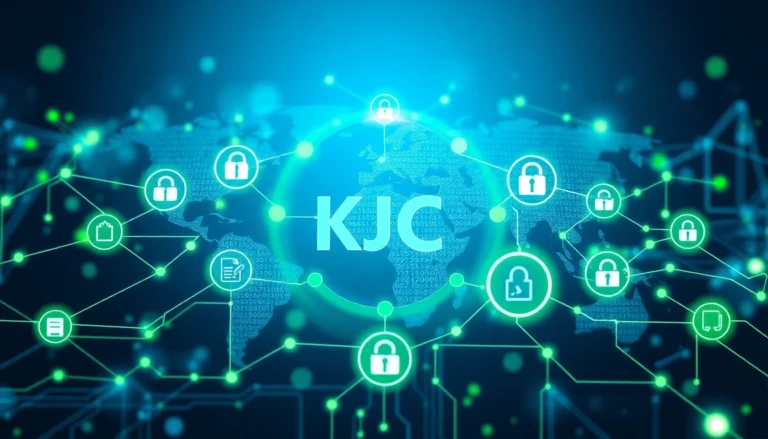
Understanding Blockchain Technology and Its Core Components
Decentralized Ledgers: The Foundation of Blockchain
At the heart of blockchain technology lies the concept of a decentralized ledger—a distributed database that records all transactions across a network of computers without a central authority. Unlike traditional ledgers maintained by a single entity, a blockchain ensures transparency and security through consensus mechanisms and cryptographic validation. This distributed nature eliminates single points of failure, enhances resilience, and fosters trust among participants. For instance, platforms like Blockchain.com demonstrate how millions of users leverage decentralized ledgers to buy, sell, and trade crypto assets with confidence, underpinning the ecosystem’s trustworthiness.
Cryptographic Security and Data Integrity
Security in blockchain primarily hinges on cryptography—specifically, cryptographic hashes and digital signatures. Each block contains a cryptographic hash of the previous block, creating an unbreakable chain that guarantees data integrity. Any alteration attempts are easily detectable, as the hash values would no longer match, alerting participants to tampering. This cryptographic framework not only secures transaction data but also ensures that information recorded is immutable. Experts from institutions such as IBM highlight that these features make blockchain a shared, immutable ledger capable of enabling secure transactions and tracking assets within complex networks.
Types of Blockchain Networks: Public, Private, and Consortium
Blockchain networks are categorized based on accessibility and control. Public blockchains, like Bitcoin and Ethereum, are open to anyone and decentralize power among all participants, fostering censorship resistance and openness. Private blockchains restrict access, controlled by a single organization, providing higher throughput and privacy for enterprise applications. Consortium blockchains strike a balance, governed collectively by a group of entities, ideal for industries requiring collaboration without fully open access. Each type serves distinct needs, from decentralized cryptocurrencies to enterprise-grade solutions concerned with confidentiality and compliance.
Real-World Applications and Industry Impact of Blockchain
Blockchain in Finance: Transactions, Payments, and Asset Management
The financial industry has been transformed by blockchain, which facilitates instant, low-cost cross-border transactions, reduces fraud, and enhances transparency. Leading exchanges like Cryptocurrency.com report that over $1 trillion in transactions have occurred since 2011, powered by blockchain’s secure infrastructure. Innovative applications include tokenized securities, real-time settlement, and decentralized exchanges (DEXs), allowing investors to access global markets efficiently. The emergence of institutional funds tokenization, which has surged 47%, exemplifies how blockchain is revolutionizing traditional asset management by enabling fractional ownership and improving liquidity.
Blockchain in Supply Chain and Logistics Optimization
Supply chain management benefits immensely from blockchain’s transparency and traceability. Companies can track goods from origin to destination, reducing counterfeiting and ensuring compliance. For example, Walmart and Maersk have adopted blockchain solutions to enhance transparency, cut delays, and improve efficiency. The immutable digital trail helps verify product authenticity, improve inventory management, and streamline movements—critical in sectors like pharmaceuticals and luxury goods where provenance is essential.
The Rise of Blockchain-Native Financial Products
Blockchain-native products like decentralized finance (DeFi) platforms, stablecoins, and tokenized funds are creating a new financial paradigm. Institutional tokenized alternative funds (IAFs) have grown dramatically, reflecting the market’s appetite for innovative, accessible financial instruments. These products allow investors to participate in yield generation, hedging, and diversification in a permissionless environment, reducing barriers posed by traditional finance. Notably, frameworks like Flare’s XRPFi are now used by corporations to optimize treasury yields, illustrating widespread enterprise adoption.
Emerging Trends and Challenges in Blockchain Adoption
Interoperability and Scalability Solutions
As blockchain technology matures, interoperability—the ability of different blockchains to communicate seamlessly—is now a top priority. Ethereum’s foundation, for example, emphasizes interoperability as a core UX goal, optimizing user experience across diverse networks. Layer 2 solutions, cross-chain bridges, and standards like RGB for stablecoins are key developments addressing scalability bottlenecks. Projects like Metaplanet have joined major indices following substantial Bitcoin purchases, reflecting confidence in scalable chains capable of handling massive transaction volumes while maintaining security.
Regulatory Environment and Legal Considerations
Regulatory uncertainty remains a significant hurdle. Governments worldwide are developing frameworks to mitigate risks like money laundering, fraud, and unregistered securities. South Korea’s crackdown on crypto hacking syndicates and Eliza Labs’ legal actions exemplify efforts to establish clearer operational boundaries. Balancing innovation with compliance is crucial; enterprises must proactively adapt to evolving laws, especially around tokenized assets, stablecoins, and enterprise usage. Clear legal frameworks will be instrumental for sustained growth and mainstream adoption.
Security Risks and Best Practices for Blockchain Implementations
Security continues to be paramount. Vulnerabilities such as MEV (Miner Extractable Value), hacking, and smart contract exploits pose threats. Industry leaders advocate for rigorous audits, secure development practices, and advanced threat detection. Initiatives like Binance’s Blockchain Yatra demonstrate that increasing community awareness and education are vital. Incorporating best practices—from secure key management to multi-layered security protocols—enables organizations to safeguard assets and maintain consumer trust.
Integrating Blockchain with Web3 and Digital Assets
Tokenization of Assets and Institutional Funds
Tokenization is revolutionizing asset management by converting physical and financial assets into digital tokens. Institutional funds, notably alternative investment funds, are increasingly utilizing blockchain for fractional ownership, liquidity, and transparency. The surge of 47% in tokenized IAFs underscores its disruptive potential. Furthermore, platforms like Amdax are raising millions to launch Bitcoin treasury companies, exemplifying how blockchain unlocks new capital markets.
Blockchain for Corporate Treasury Management
Innovative companies adopt blockchain frameworks like XRPFi to optimize treasury yields, making their cash management more efficient and transparent. Blockchain’s programmable nature enables corporations to automate liquidity management, monitor holdings in real-time, and enhance compliance. As seen with recent strategic purchases of Bitcoin totaling millions, firms recognize the value of holding digital assets for treasury purposes, positioning blockchain as a vital enabler for corporate finance.
Decentralized Finance (DeFi) and On-Chain Capital Markets
DeFi has created a decentralized alternative to traditional financial services—lending, borrowing, trading, and yield farming—implemented fully on-chain. These on-chain capital markets are building a parallel financial infrastructure outside legacy walls, effectively building “Wall Street without walls.” This paradigm shift unlocks global participation, democratizes access, and introduces innovative instruments like tokenized hedge funds and derivatives. The rapid growth in these markets signifies a profound transformation in how wealth is created and stored.
Future Outlook: Innovations and Opportunities in Blockchain Evolution
Next-Generation Blockchain Protocols and Frameworks
The blockchain ecosystem is continuously evolving with protocols designed for higher throughput, lower latency, and enhanced security. Layer 2 solutions like zk-rollups and optimistic rollups are already facilitating massive scalability, enabling complex DeFi applications and enterprise use-cases. Future frameworks will integrate seamlessly with AI, IoT, and 5G technologies, creating ubiquitous, intelligent, and autonomous systems capable of new levels of efficiency and innovation.
Impact of AI and IoT on Blockchain Ecosystems
The symbiosis between blockchain, AI, and IoT heralds a new era of smart, autonomous systems. AI can optimize transaction validation and security, while IoT generates real-time data feeds for supply chains, smart cities, and healthcare. Projects are already exploring how AI-powered digital twins, in collaboration with blockchain’s immutability, can revolutionize industries like real estate and manufacturing, creating resilient, transparent digital ecosystems.
Strategies for Business Adoption and Competitive Advantage
Businesses aiming to leverage blockchain must focus on strategic integration—identifying pain points, selecting suitable protocols, and ensuring compliance. Early adopters will benefit from enhanced transparency, reduced costs, and new revenue streams. Building partnerships with industry leaders, investing in R&D, and fostering community engagement are critical for maintaining a competitive edge. As the market matures, organizations that embed blockchain into their core operations will redefine industry standards and customer expectations.






